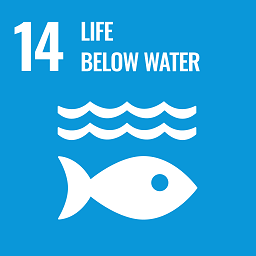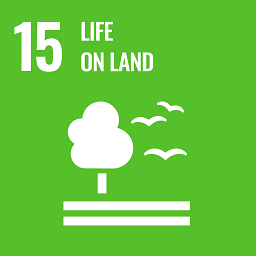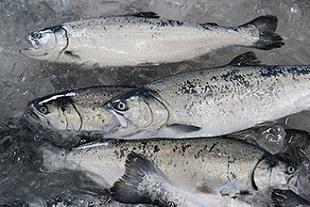Outcome Example of Bio-oriented Technology Research Advancement Institution
Issued on July 15, 2020


Aiming at raising purely domestic brand salmons
Do you know coho salmon raised by giving rice, the staple food in Japan, as feed? Most coho salmons aquacultured in Miyagi are raised by the feed mixed with rice from Miyagi. Salmon farmers aim to establish purely domestic brand salmons from Miyagi considering overseas export.
The production of salmons in Miyagi accounts for 80% or more of domestic production
Miyagi is the place where coho salmons were first successfully aquacultured in the 1970s in Japan. The Pacific coast of Miyagi is formed by the buff ria coast, which is suitable for the aquaculture of salmons. Central culture farms include sea areas along Minami-sanriku-cho, Onagawa-cho, and Ishinomaki-shi facing the Pacific coast. The share of salmons from Miyagi accounts for 80% or more of the domestic share. Coho salmons do not migrate upstream into Japanese rivers. The aquaculture season is limited to the period from November to July, and the peak of shipping is from June to July.
Miyagi is blessed with a geographical advantage but engages in fierce competition with the places where salmons are aquacultured in foreign countries such as Chile and Norway. In Japan, the primary raw material for feed depends mostly on imports, raising the problem of unstable feed cost. This is one of the issues to be solved. Recently, there is a growing trend toward the aquaculture of salmons in other areas in Japan. The need is increasingly growing for differentiation from other aquaculture places to create originality. Against this background, the idea of giving rice to salmons as feed has been planned out.
 |
| Image 1: Silvery color of coho salmon(Supplied by Miyagi Coho Salmon Promotion Association) |
Rice from Miyagi may be supplied stably
Salmon farmers and distributors formed "Miyagi Coho Salmon Promotion Association" in 2013 and engaged in quality improvement and branding. Their big challenge is to use rice from Miyagi as feed. Generally, about half of formula feed for salmon aquaculture is a fish meal made of sardine and others, and the other half is the mixture composed of crops such as wheat, soybeans, and oils and fats. Unfortunately, about 90% of the raw material for the feed depends on imports. Dependence on imports may lead to unstable costs due to exchange fluctuation, causing a squeeze on management.
To address this problem, an idea that rice from Miyagi is used for feed was planned out. Under the leadership of Professor Minoru Sato at Graduate School of Agricultural Science, Faculty of Agriculture, Tohoku University, Miyagi Prefecture Fisheries technology Institute, and Japan Fisheries Research and Education Agency, an experiment in which rice-mixed feed is given to coho salmons was started in salmon farms, including Minami-sanriku-cho in 2016.
The feed with rice cultivar and composition varied was experimentally given to coho salmons. The result demonstrated that the juveniles, which had feed composed of fish meal with the same composition rate as existing one and rice at the rate of 20%-25% rather than wheat, were raised to adult fish with the same quality as that of the adult fish having an existing feed. No difference in taste, texture, and appearance was observed between coho salmons with different feeds given. The conversion coefficient, which indicates how much feed is required to raise 1 kg fish, is at the same level as the existing feed, 1.2 to 1.4.
After this trial and error, feed mixed with 30% rice from Miyagi for aquaculture was first developed in 2018 (Image 2). At present, about 60 management bodies that operate aquaculture coho salmons exist in Miyagi. Sixteen in Minami-sanriku-cho and other places, among sixty management bodies, use rice-mixed feed for raising juveniles. The estimated production of coho salmons with rice-mixed feed given is ~3,400 tons, accounting for ~30% of the total production in Miyagi.
 |
| Image 2: Feed mixed with rice from Miyagi(Supplied by Miyagi Coho Salmon Promotion Association) |
Acquired Certification of Geographic Indication (GI)
Coho salmons aquacultured in Miyagi, including those raised with rice-mixed feed, were registered under the name "Salmons from Miyagi" as Protected Geographical Indication (GI) in Japan in 2017. This feature was first achieved in the agricultural ad fishery products from Miyagi. The Protected GI System is intended to protect the names of the local products, which reflect the features of the places of production and are highly rated.
High-quality and high-freshness salmons from Miyagi are characterized in that they undergo the freshness keeping process to keep the excellent taste specific to coho salmons. Sliced salmons from Miyagi are glossy and firm, making them precisely suitable for sashimi sliced raw fish), in which we take pride. Salmons from Miyagi, which are less oily and sweeter than imported salmons, are healthy foods.
Aiming to develop value-added salmon products, "Salmon from Miyagi SMOKE" smoked with chips of chestnut trees collected in the mountains of Miyagi, and " Oshizushi" were created by the fishery companies in Miyagi. They are engaged in All-Miyagi Project. In January 2020, they participated in the Japanese Food Event held in California, U.S.A., and received good reviews.
Expansion into overseas markets
Coho salmon farmers and processing companies aim to expand high-quality salmons from Miyagi into the overseas markets. However, marine products, including coho salmons, are easy to deteriorate and should be transported in a frozen state. The "Smart thawing technique" developed by Tohoku University and other institutes effectively address this problem. It is a thawing technique using electromagnetic waves similar to those of a microwave oven. Frozen products are easy to thaw rapidly and uniformly without drips, discoloration, and unpleasant odors. It enables consumers to rapidly thaw and take frozen products anywhere.
Project name
The special scheme project on advanced research and development for next-generation technology (Regional Strategy Project)
Project period
FY 2016 to 2019
Title
Development of a technique for aquaculturing purely domestic coho salmons primarily with rice-mixed feed and the expansion of salmon products from Miyagi into overseas markets through developing an innovative freezing-thawing technique.
Leading research institute
Graduate School of Agricultural Science, Faculty of Agriculture, Tohoku University
